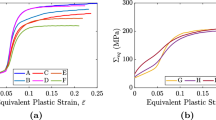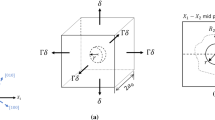Abstract
Micro-mechanical 2D cell model studies have revealed ductile failure during intense shearing to be governed by the interaction of neighbouring voids, which collapse to micro-cracks and continuously rotate and elongate until coalescence occurs. For a three-dimensional void structure, this implies significant straining of the matrix material located on the axis of rotation. In particular, the void surface material is severely deformed during shearing and void surface contact is established early in the deformation process. This 3D effect intensifies with decreasing stress triaxiality and complicates the numerical analysis, which is also reflected in published literature. Rather than moving towards very low triaxiality shearing, work has focused on extracting wide-ranging results for moderate stress triaxiality (T ~ 1), in order to achieve sufficient understanding of the influence of initial porosity, void shape, void orientation etc. The objective of this work is to expand the range of stress triaxiality usually faced in 3D cell model studies, such that intense shearing is covered, and to bring forward details on the porosity and void shape evolution. The overall material response is presented for a range of initial material configurations and loading conditions. In addition, a direct comparison to corresponding 2D cell model predictions for circular cylindrical voids under plane strain shearing is presented. A quantitatively good agreement of the two model configurations (2D vs. 3D) is obtained and similar trends are predicted. However, the additional layer of matrix material, connecting voids in the transverse direction, is concluded to significantly influence the void shape evolution and to give rise to higher overall ductility. This 3D effect is demonstrated for various periodic distributions of voids.
Similar content being viewed by others
References
ABAQUS (2010) ABAQUS Theory Manual, version 6.10, SIMULIA Corp
Anderson P, Fleck N, Johnson K (1990) Localization of plastic deformation in shear due to micro-cracks. J Mech Phys Solids 38: 681–699
Bao Y, Wierzbicki T (2004) On fracture locus in the equivalent strain and stress triaxiality space. Int J Mech Sci 46: 81–98
Barsoum I, Faleskog J (2007a) Rupture mechanisms in combined tension and shear—experiments. Int J Solids Struct 44: 1768–1786
Barsoum I, Faleskog J (2007b) Rupture mechanisms in combined tension and shear—micromechanics. Int J Solids Struct 44: 5481–5498
Barsoum I, Faleskog J (2011) Micromechanical analysis on the influence of the lode parameter on void growth and coalescence. Int J Solids Struct 48: 925–938
Belytschko T, Liu W, Moran B (2000) Nonlinear finite elements for continua and structures. Wiley, New York
Benzerga A (2002) Micromechanics of coalescence in ductile fracture. J Mech Phys Solids 50: 1331–1362
Chu A, Needleman A (1980) Void nucleation effects in biaxially stretched sheets. J Eng Mater Technol 102: 249–256
Dahl J, Nielsen K, Tvergaard V (2012) Effect of contact conditions on void coalescence at low stress triaxiality Shearing. J Appl Mech. doi:10.1115/1.4005565
Fleck N, Hutchinson J, Tvergaard V (1989) Softening by void nucleation and growth in tension and shear. J Mech Phys Solids 37: 515–540
Gao X, Zhang G (2010) A study on the effect of the stress state on ductile fracture. Int J Damage Mech 19: 75–94
Gologanu M, Leblond J, Devaux J (1993) Approximate models for ductile metals containing nonspherical voids—case of axisymmetrical prolate ellipsoidal cavities. J Mech Phys Solids 41: 1723–1754
Gologanu M, Leblond J, Devaux J (1994) Approximate models for ductile metals containing nonspherical voids—case of axisymmetrical oblate ellipsoidal cavities. J Eng Mater Technol 116: 290–297
Gologanu M, Leblond J, Perrin G, Devaux J (1997) Recent extensions of Gurson’s model for porous ductile metals. In: Continuum micromechanics, Springer, Berlin, pp 61–106
Gurson A (1977) Continuum theory of ductile rupture by void nucleation and growth—part I: yield criteria and flow rules for porous ductile media. ASME J Eng Mater Technol 99: 2–15
Jodlowski T (2011) Mechanics of growth and coalescence of pre-existing voids in a ductile matrix. PhD thesis, École polytechnique fédérale de lausanne, Université de Lausanne
Koplik J, Needleman A (1988) Void growth and coalescence in porous plastic solids. Int J Solids Struct 24: 835–853
Lassance D, Fabrègue D, Delannay F, Pardoen T (2007) Micromechanics of room and high temperature fracture in 6xxx Al alloys. Prog Mater Sci 52: 62–129
Leblond JB, Mottet G (2008) A theoretical approach of strain localization within thin planar bands in porous ductile materials. C R Mecanique 336: 176–189
Li Z, Steinmann P (2006) RVE-based studies on the coupled effects of void size and void shape on yield behavior and void growth at micron scales. Int J Plast 22: 1195–1216
McVeigh C, Vernerey F, Wing K, Moran B, Olson G (2007) An interactive micro-void shear localization mechanism in high strength steels. J Mech Phys Solids 55: 225–244
Nahshon K, Hutchinson J (2008) Modification of the Gurson model for shear. Euro J Mech A/Solids 27: 1–17
Needleman A (1972) Void growth in an elastic-plastic medium. J Appl Mech 39: 964–970
Nielsen K (2010) Predicting failure response of spot welded joints using recent extensions to the Gurson model. Comp Mater Sci 48: 71–82
Nielsen K, Tvergaard V (2011) Failure by void coalescence in metallic materials containing primary and secondary voids subject to intense shearing. Int J Solids Struct 48: 1255–1267
Pardoen T, Hutchinson J (2000) An extended model for void growth and coalescence. J Mech Phys Solids 48: 2467–2512
Scheyvaerts F (2008) Multiscale modeling of ductile fracture in heterogeneous metallic alloys. PhD thesis, École polytechnique de Louvain, Université catholique de Louvain
Simar A, Nielsen K, de Meester B, Tvergaard V, Pardoen T (2010) Micro-mechanical modeling of ductile failure in 6005A aluminium using a physics based strain hardening law including stage IV. Eng Frac Mech 77: 2491–2503
Tekoglu C, Leblond JB, Pardoen T (2012) A criterion for the onset of void coalescence under combined tension and shear (submitted)
Thomason P (1990) Ductile fracture of metals. Pergamon press, Oxford
Tvergaard V (1981) Influence of voids on shear band instabilities under plane strain conditions. Int J Fract 17: 389–407
Tvergaard V (1982) On localization in ductile materials containing spherical voids. Int J Frac 18: 237–252
Tvergaard V (1989) Numerical study of localization in a void-sheet. Int J Solids Struct 25: 1143–1156
Tvergaard V (2008) Shear deformation of voids with contact modelled by internal pressure. Int J Mech Sci 50: 1459–1465
Tvergaard V (2009) Behaviour of voids in a shear field. Int J Fract 158: 41–49
Tvergaard V (2012) Effect of stress-state and spacing on voids in a shear-field (to appear)
Tvergaard V, Needleman A (1984) Analysis of the cup-cone fracture in a round tensile bar. Acta Metall 32: 157–169
Tvergaard V, Nielsen K (2010) Relations between a micro-mechanical model and a damage model for ductile failure in shear. J Mech Phys Solids 58: 1243–1252
Author information
Authors and Affiliations
Corresponding author
Rights and permissions
About this article
Cite this article
Nielsen, K.L., Dahl, J. & Tvergaard, V. Collapse and coalescence of spherical voids subject to intense shearing: studied in full 3D. Int J Fract 177, 97–108 (2012). https://doi.org/10.1007/s10704-012-9757-4
Received:
Accepted:
Published:
Issue Date:
DOI: https://doi.org/10.1007/s10704-012-9757-4




